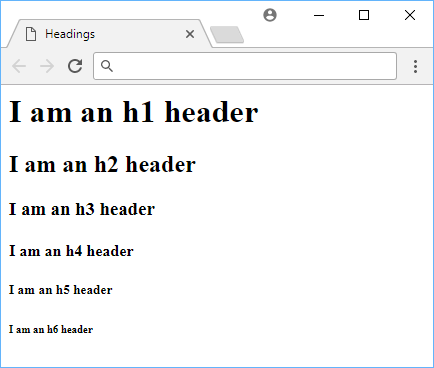Page headings are important. They help set the tone for the rest of the page, and they are usually in a bigger font, so users notice them. Not only that, but headings are important for search engines too. Let's learn about the different types of headings, what the different levels mean, and how to use them.
Headings
Whenever you want to give your page a heading, HTML has you covered as you have many tags at your disposal.
HTML offers you six different tags, to be more precise. They are:
h1tagh2tagh3tagh4tagh5tagh6tag
HTML<!DOCTYPE html>
<html>
<head>
<title>Headings</title>
</head>
<body>
<h1>I am an h1 header</h1>
<h2>I am an h2 header</h2>
<h3>I am an h3 header</h3>
<h4>I am an h4 header</h4>
<h5>I am an h5 header</h5>
<h6>I am an h6 header</h6>
</body>
</html>
 All the heading tags.
All the heading tags.
- HTML
Headings are important because they help describe what the page is about and help you establish hierarchy in your page. Do not use them for styling, only for describing how important the heading is in your page.
Resources
Leave us a message!
×
 Managing PHP Dependencies with Composer
Managing PHP Dependencies with Composer Create an RSS Reader in Node
Create an RSS Reader in Node How to Set Up Cron Jobs in Linux
How to Set Up Cron Jobs in Linux How to deploy a .NET app using Docker
How to deploy a .NET app using Docker Best Visual Studio Code Extensions for 2022
Best Visual Studio Code Extensions for 2022 How to build a Discord bot using TypeScript
How to build a Discord bot using TypeScript How to deploy a PHP app using Docker
How to deploy a PHP app using Docker Getting Started with Deno
Getting Started with Deno How to deploy a Node app using Docker
How to deploy a Node app using Docker Learn how to use v-model with a custom Vue component
Learn how to use v-model with a custom Vue component Creating a Twitter bot with Node.js
Creating a Twitter bot with Node.js Getting Started with Vuex: Managing State in Vue
Getting Started with Vuex: Managing State in Vue
